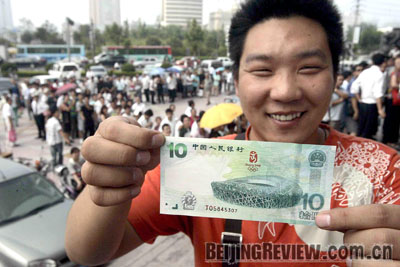|

GET IT: A local resident gets an Olympic memorial banknote from the Zhengzhou
Branch of Bank of Communications, Henan Province
Shu Wen had no idea the Chinese collectors' market was so popular. The Ph.D. in sociology, returning to China from France, had researched this market as part of his studies but was totally unprepared for what he found.
On July 7, while on a business trip to Shanghai, Shu, now a member of the Beijing Association of Collectors, was surprised to see long lines in front of the branches of all five major state-owned commercial banks. After returning to Beijing early the next day, he saw the same scenes in Beijing. Later, he learned from a news report that these people were queuing for a Beijing Olympic memorial bank note issued by China's central bank, the People's Bank of China on July 8. Before the 10-yuan ($1.45) face value banknotes hit the market, their value in the option market had already soared to between 400 and 600 yuan ($58 to $87).
As China's economy continues to grow and more disposable income is available, increasing numbers of ordinary people are becoming collectors. Based on membership information from the China Association of Collectors, Shu estimated that the number of collectors in China is between 30 million and 40 million. Shu said that some experts estimate that if unregistered collectors were counted, the total number of collectors could exceed 70 million, accounting for roughly 6 percent of the total population. People are drawn into collecting antique items for various reasons, some to reminisce about the past, others for fun, self-education or financial reward, he said.
There have been five waves of public collecting fever in China's ancient history, Shu said. The previous four mainly involved high-ranking officials or the rich, whereas the recent wave has attracted people from different social strata.
Collectors' heaven
One of these venues is Panjiayuan, a flea market in southwest Beijing and a collector's delight that offers a glimpse of how rich the collectors' world is. The market, equal in size to seven standard football fields, is strewn with wide varieties of antiques and artifacts, from porcelain and jade to old books and antique furniture. The market is a must for "red collectors," people collecting items from the Cultural Revolution (1966-76). In recent years, Mao's "little red book," badges bearing Mao image and propaganda photos and posters have been very popular in private or government-run auctions.
Propaganda posters were widely used in China in the 1950s and 60s. Few of the original pictures remain intact today and in recent years their market value has skyrocketed.
|
